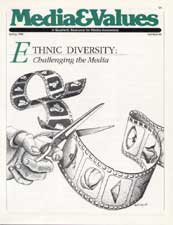Hollywood's Arab: Still Stuck in the Desert
|
This article originally appeared in Issue# 43
|
For years moviegoers have been offered stereotypical images of the Arab. The stereotype provides myths and misperceptions which then to influence public opinion and limit the formulation of a successful policy in the Middle East.
The Arab male is portrayed as a contemptible character — cowardly, primitive, ignorant, cruel, vicious, lecherous and, often, fabulously wealthy. An Arab woman is either a sensuous belly dancer, whore, terrorist or a veiled, silent appendage to her husband.
Filmmakers too often dip into their script bags for the "Instant Arab Kit." For women, it contains belly dancers' outfits and veils; for men, it consists of kuffiyahs, flowing robes, sunglasses, scimitars, limousines and camels. Oil wells, sand dunes and souks set the scene.
In many films released in the mid-1980s, the Hollywood Arab prowls the screen amidst a mishmash of misinformation. Viewers see a disturbing recurrence of similarly negative characters, with inaccurate or stereotypical settings. The interchangeable set of "Arabland" invariably show Israeli and American actors as veiled women in black, shabbily dressed men, ferocious terrorists, belly dancers, armed guards and evil dictators. The desert set offers a similar cast of characters, including sheep, horses and camels. Into the perennial desert the producers drop a military air base or a cheap mockup of an Arabian Nights' palace. Urban settings offer sheikhs in sunglasses doing dastardly deeds in black limousines or glittering Mercedes. Producers fail to show today's Arabian cities. Their message is: You can take the Hollywood Arab out of the desert, but you can't take the desert out of the Hollywood Arab.
Stereotypes form "pictures in our heads," and pictures relay powerful messages. Concerned moviemakers could channel such messages in a constructive or entertaining manner. But films cannot be entertaining or their messages constructive when a people is dehumanized. It is time for filmmakers to revise their perception of "Arabland" and begin to portray a new Hollywood Arab.



